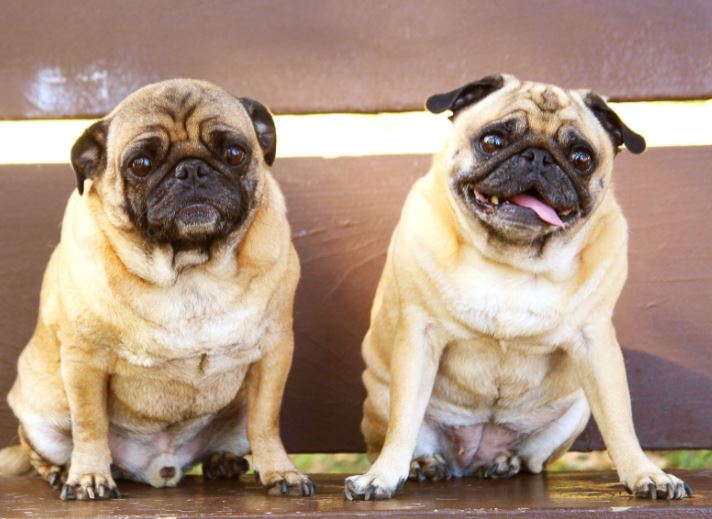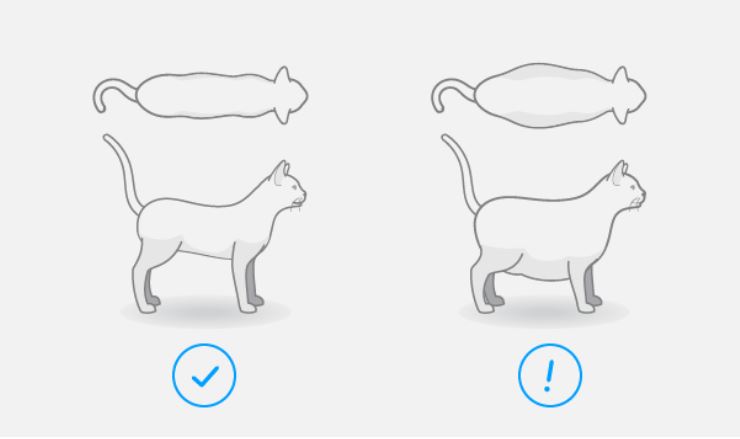

None of us likes to face the fact that our fur-child is fat. The scales have crept up; he’s not as active as he used to be, sometimes struggles to join in the family fun… but he’s just chubby, and we love him regardless. That’s okay, right?
Sadly, as with us, when we pile on the pounds, it’s never healthy for our pets to be overweight. These are the top reasons why weight gain should be avoided at all costs:
Diabetes
Yes, dogs, cats and other pets can become diabetic due to excess weight. With 2 out of every 3 pets found to be overweight or obese at their veterinary check-ups, this is becoming a growing health problem. While diabetes is by no means a death sentence if caught early and treated correctly, it’s a challenging condition to manage. It is easily avoided by keeping your pet at an ideal weight.
Joint Problems
Our bones and joints are what hold us up, and any extra weight puts pressure on them. Fat deposits have also been shown to release pro-inflammatory agents. Excess weight can dramatically increase the risk of your pet developing joint inflammation and osteoarthritis, an exceptionally painful, permanent and ultimately debilitating disease. Such is the prevalence of this condition, particularly amongst large and giant breed dogs and cats, that veterinary orthopaedic surgeons recommend keeping these animals very lean, even a bit ‘ribby’, lifelong. Equally at risk are breeds with oddly-shaped skeletons like dachshunds, bassets, bulldogs and munchkins. Carrying just 5% excess weight can significantly affect your pet’s quality of life and life expectancy.
Heart Disease
Being overweight or obese causes strain for all the organs, particularly the heart, which has to pump blood through loads of extra tissue. Fat accumulates around all the vital organs, limiting the space for the heart and lungs to function. The result: the heart literally ‘wears out’. No one wants to see their pet feeling listless and lethargic, suffering fainting spells, at risk of heatstroke or battling to breathe normally.
Skin and Urinary Tract Infections
Overweight animals develop rolls of fat. The folds in between provide ideal breeding grounds for bacteria, resulting in a host of uncomfortable, itchy, and oozy skin irritations. Of particular concern are the areas where urine may accumulate in skin folds and cause discomfort and serious infections as the bacteria migrate up into the urinary system. Added to this is the fact that, like an overweight person who can’t touch his toes because of his ample girth, fat animals can’t groom their bodies properly, purely because they can’t reach.
Anaesthetic Risk
Possibly one of the most concerning factors is that a dog or cat who is over his ideal body weight becomes an anaesthetic risk. This means that if a flabby pet ever has to undergo emergency surgery, be it due to being hit by a car, breaking a bone, or suffering an illness that requires an operation, the likelihood of him running into serious problems under anaesthetic, or even passing away, is dramatically increased as opposed to an animal of healthy weight!


The CVC team can help you determine if your pet is overweight, how many kilos need to be lost in order to reach the ideal body weight and even set you up with a game plan.
These helpful hints will ensure your pet is happy, healthy and beach-ready in no time:
Diet
It’s obvious that calories will need to be reduced and portions controlled, and there are a variety of superb veterinary formulated weight management diets available to reduce both your pet’s weight and the stress for you. Depending on how much needs to be lost, we may recommend either a ‘Lite’ food or a prescription weight reduction formula. These special calorie-controlled pet foods are based on cutting-edge nutritional science – they not only provide all the nutrients your chubby pet needs, despite reducing fat, carbs, etc., but some, like the Hills Prescription Diet Metabolic range, are formulated to make changes at a cellular level; they literally turn your pet into a ‘fat burner’ instead of a ‘fat storer’! Unfortunately, just dishing out less of your pet’s usual diet is ineffective, as an overweight body is geared to survive on very little food. Also, an imbalance of essential nutrients can result from simply feeding your pet less.
Discipline
Everyone in the household needs to be aware of the seriousness of your pet’s weight problems, most especially the health risks of not slimming down. All too often, there are one or two ‘culprits’ in the family who feel sorry for Fat Felix or Roly Rover and sneak him treats on the sly. Everyone needs to be committed to helping your pet reach its goal weight and feel amazing. Ensure that portion control is exercised by everybody who feeds your dog or cat – draw a clear line on the plastic measuring cup, or even cut it at the exact level if you’re inclined to be a little ‘heavy-handed’ when dishing out the food.
Treats
Just because your pet can’t indulge in his favourite peanut butter bedtime cookie anymore doesn’t mean he shouldn’t have treats or rewards. Dogs enjoy some vegetable matter in their diets, and carrot or apple (without the pips), for example, grated to prevent choking hazards, are fantastic low-calorie snacks that can be offered in between meals to stave off the hunger pangs. And remember that not all treats need to be food treats. Most cats get a serious kick out of some catnip sprinkled on a favourite toy or scratch post, and dogs will welcome any kind of activity that involves spending time with the family.
Exercise
While exercise is a vital aspect of any weight loss programme, remember that your overweight pet may already be suffering from sore joints, breathing problems, etc., or simply be battling to drag the extra pounds around. Start by introducing gentle exercise, even if it’s just an amble around the garden or the block, or a short game of fetch with a favourite toy. Engage cats in short but regular games of chase (find out which type of toy takes your feline’s fancy – laser pointers and feather wands are usually winners). Energy levels and stamina will quickly improve as the weight comes off. Whatever you do, don’t allow your pet to lie around all day. Keep in mind that he might be doing so because his limbs are sore, but encourage him to get up and move around regularly, even if just for a few minutes each time. As your pet’s fitness increases, get him moving up and down the stairs too. Finally, swimming and walking on an underwater treadmill are incredible forms of exercise for overweight or obese pets. They alleviate all stress on the joints while burning loads of calories.
Don’t despair if your favourite furball has packed on the pounds – we are here to provide you with all the support you need to help you slim down your portly pet. Visit us today for a weight assessment for your pet, and get ready to say hello to a healthier, happier pet in the months to come.
